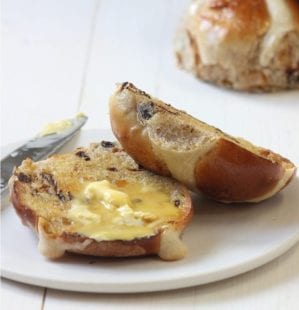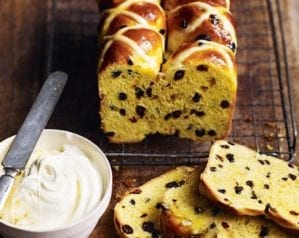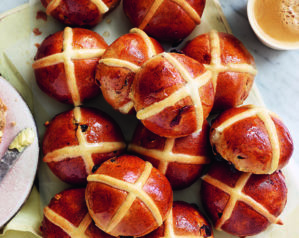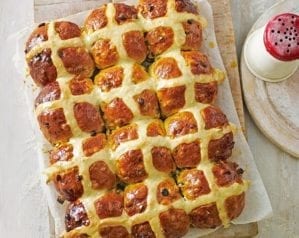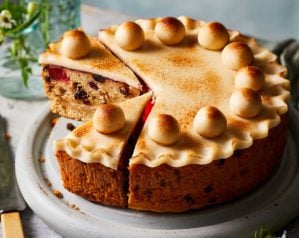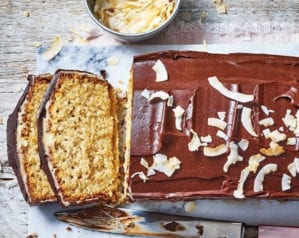
Orange hot cross bun loaf
- Published: 17 Apr 19
- Updated: 18 Mar 24
A twist on the Easter tradition of hot cross buns, this orange and anise hot cross bun loaf is best served sliced with butter and marmalade.
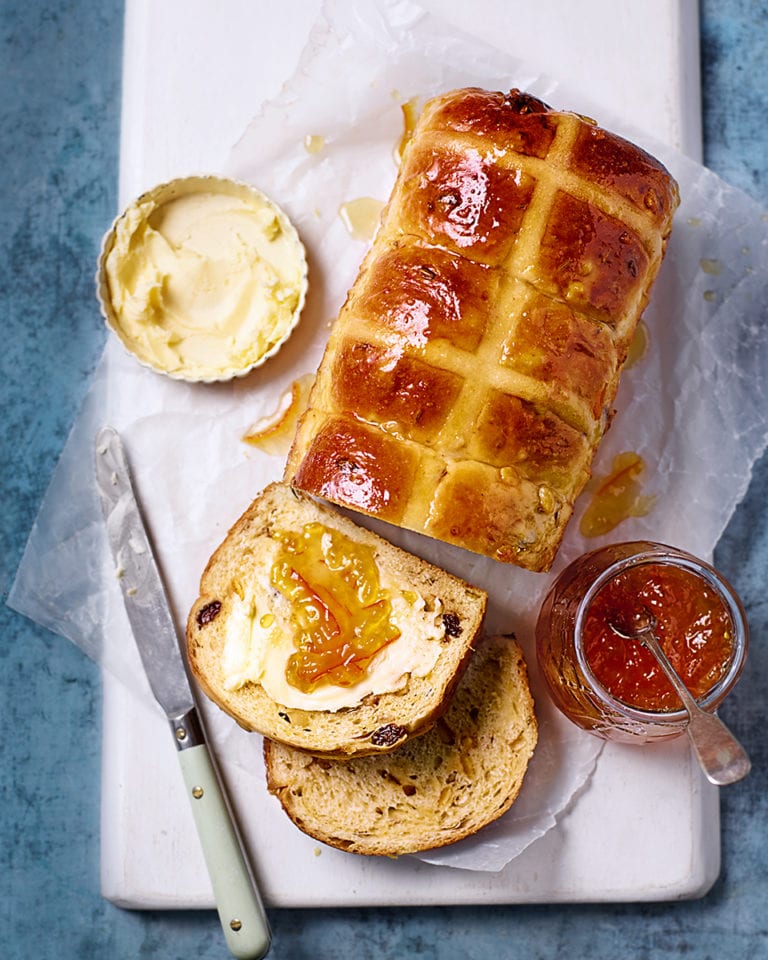
And for a classic hot cross bun recipe, try these golden saffron hot cross buns.
-
Makes 2 x 650g loaves
-
45 min, oven time 25 min, plus overnight resting and at least 3 hours proving
Ingredients
For the sponge (see know-how)
- 120g ‘00’ flour (see Fergus’s tips)
- ¼ tsp dried yeast
For the dough
- Finely grated zest 1 large orange and juice ½
- 160g candied orange peel
- 12g aniseed (or fennel seeds – see tips)
- 80g raisins or currants
- 445g ‘00’ flour, plus extra for dusting (see tips)
- 110ml whole milk, scalded (see tips)
- 45g free-range egg, beaten (see food team’s tip) plus 1 medium free-range egg, beaten, for glazing
- 10g salt
- 1 tsp dried yeast
- 60g caster sugar
- 60g unsalted butter, softened
For the cross topping
- 40g plain flour
- 20g self-raising flour
- Pinch caster sugar
- 2 tsp veg oil, plus extra to grease
- 1 tbsp marmalade to glaze
You’ll also need…
- Stand mixer with dough hook
- 2 x 1.5lb/680g loaf tins, lightly buttered
- Disposable piping bag
Method
- Mix the sponge ingredients with a large pinch of salt and 80ml room temperature water in a small bowl to form a stiff dough. Cover with cling film and leave for 12 hours at room temperature. It should more than double in size.
- The next day, mix the orange zest and juice, candied peel, aniseed/fennel seeds and raisins/currants in a mixing bowl, then set aside to soak.
- Weigh 190g of the sponge mix, tear it into pieces and put in the bowl of a stand mixer with a dough hook attached. Add the flour, milk, 45g egg, salt, yeast and 135ml room temperature water.
- Mix on a low speed for 2 minutes, scrape the sides of the bowl down with a spatula or palette knife, then mix for another minute or so until all the dry ingredients are incorporated.
- Increase the speed to medium. After about 5 minutes, the dough should be smooth and elastic. If it’s still looking a bit ragged or uneven, keep mixing until smooth.
- By this point, the dough should be ready for the sugar and butter. Still on a medium speed, add the sugar to the bowl, bit by bit. The dough will become softer and stickier. Carry on mixing until the dough comes back together (this should take 2 minutes or so).
- Cut the butter into 4-5 pieces and add them to the bowl, then mix again on a medium speed for 2 minutes or so until fully incorporated (scrape down the sides of the bowl if necessary).
- Finally, add the soaked fruit mixture to the bowl and mix on a low speed until well incorporated.
- Transfer the dough to a lightly oiled bowl and cover with cling film or a clean tea towel. Leave to rise at room temperature until at least doubled in size (about 1½ hours).
- Once the dough has risen, turn it out onto a lightly floured work surface and knock back (knead gently to remove any large air pockets). Divide into 6 equal portions, about 215g each, then shape into tight dough balls. Put
3 balls, side by side, into each of the prepared loaf tins. Cover the tins with a clean tea towel and leave to prove for 1½-2 hours. - While the loaves are proving, make the cross topping. Put all the ingredients except the marmalade in a bowl with a pinch of salt. Add 50ml cold water and mix well until smooth. Scrape into a piping bag and set aside. Heat the oven to 200ºC/180ºC fan/gas 6.
- When the dough has at least doubled in size, brush generously with beaten egg all over, then pipe the topping in 1 long stripe down the centre, followed by 3 short ones across the top of each dough ball.
- Bake for 25 minutes until the tops of the loaves look golden. Just before the baking time is up, warm the marmalade in a small pan with a little water to make a thick syrup. As soon as the loaves come out of the oven, remove from the tins, transfer to a wire rack and brush all over with the glaze. Leave to cool before slicing.
- Recipe from April 2019 Issue
Nutrition
- Calories
- 164kcals
- Fat
- 3.2g (1.6g saturated)
- Protein
- 3.3g
- Carbohydrates
- 29.9g (8.5g sugars)
- Fibre
- 1.4g
- Salt
- 0.5g
delicious. tips
Aniseed (anise) is hard to find but you can buy it at souschef.co.uk.
‘00’ flour sits between strong bread flour and soft plain flour, giving structure and tenderness.
Scalding the milk (heating it just to below boiling point) denatures proteins that could make the loaves heavy. Make sure you cool the milk to room temperature before using.
A medium egg weighs about 50g (not including the shell). This recipe requires precision so beat one egg, weigh it and keep any surplus for glazing.
Well wrapped, the finished loaves will keep for up to 3 days.
A sponge is pre-fermented dough that you add to your bread mix, boosting flavour and meaning less yeast is needed.
Buy ingredients online
Rate & review
Rate
Reviews
Subscribe to our magazine
Food stories, skills and tested recipes, straight to your door... Enjoy 5 issues for just £5 with our special introductory offer.
Subscribe
Unleash your inner chef
Looking for inspiration? Receive the latest recipes with our newsletter

